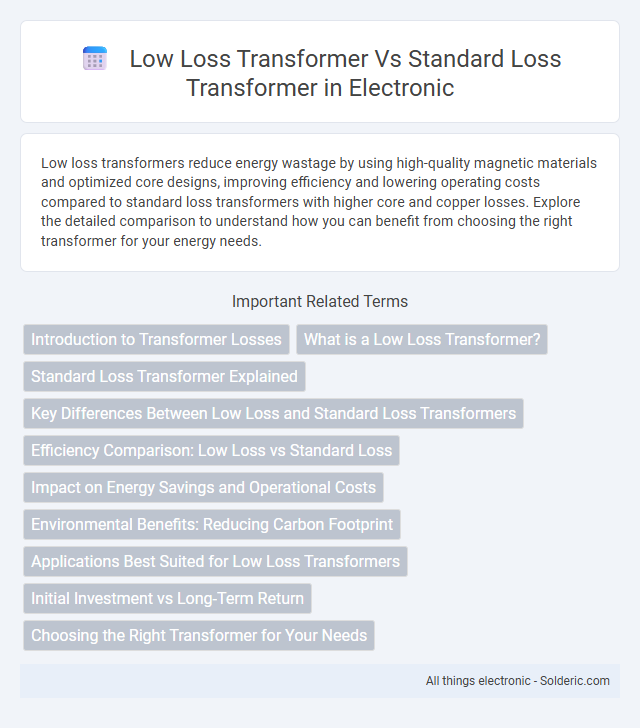Low loss transformers reduce energy wastage by using high-quality magnetic materials and optimized core designs, improving efficiency and lowering operating costs compared to standard loss transformers with higher core and copper losses. Explore the detailed comparison to understand how you can benefit from choosing the right transformer for your energy needs.
Comparison Table
| Feature | Low Loss Transformer | Standard Loss Transformer |
|---|---|---|
| Core Material | High-grade silicon steel, amorphous steel | Conventional silicon steel |
| Energy Efficiency | 95-99% | 90-95% |
| Core Loss | Significantly reduced | Higher core losses |
| Operating Temperature | Lower temperature rise | Higher temperature rise |
| Initial Cost | Higher | Lower |
| Lifecycle Cost | Lower, due to energy savings | Higher, due to energy losses |
| Applications | Energy-sensitive operations, industrial use | General-purpose power distribution |
| Environmental Impact | Reduced CO2 emissions | Higher emissions due to losses |
Introduction to Transformer Losses
Transformer losses primarily consist of core (iron) losses and copper losses, affecting efficiency and performance in electrical systems. Low loss transformers utilize advanced core materials and optimized winding designs to minimize hysteresis and eddy current losses, resulting in reduced energy dissipation compared to standard loss transformers. Consequently, low loss transformers offer improved energy efficiency, lower operating costs, and enhanced environmental sustainability in power distribution networks.
What is a Low Loss Transformer?
A low loss transformer is designed using advanced core materials like amorphous steel or high-grade silicon steel to minimize energy dissipation, significantly reducing core and copper losses compared to standard loss transformers. These transformers enhance energy efficiency by lowering no-load and load losses, which leads to reduced electricity bills and a smaller environmental footprint. Your choice of a low loss transformer improves power quality and reliability while supporting sustainability goals in electrical systems.
Standard Loss Transformer Explained
Standard loss transformers typically experience higher core and copper losses due to traditional materials and design, resulting in reduced efficiency. These transformers use conventional silicon steel cores and standard winding configurations, which generate more heat and energy dissipation during operation. In contrast, low loss transformers incorporate advanced alloys and optimized designs to minimize these losses, improving overall energy savings and performance.
Key Differences Between Low Loss and Standard Loss Transformers
Low loss transformers significantly reduce core and copper losses compared to standard loss transformers, leading to higher energy efficiency and lower operating costs. They utilize superior magnetic materials such as amorphous steel or high-grade silicon steel, resulting in reduced hysteresis and eddy current losses. This enhanced performance makes low loss transformers ideal for applications requiring continuous operation and long-term energy savings.
Efficiency Comparison: Low Loss vs Standard Loss
Low loss transformers achieve higher efficiency by minimizing core and copper losses, typically resulting in energy savings of 2-5% compared to standard loss transformers. This efficiency gain reduces operational costs and extends equipment lifespan, especially in high-load applications. Advanced materials such as amorphous steel and optimized winding techniques contribute significantly to the improved performance of low loss transformers.
Impact on Energy Savings and Operational Costs
Low loss transformers reduce energy losses by using high-quality materials and advanced designs, resulting in significant energy savings compared to standard loss transformers. These savings directly lower operational costs through decreased electricity consumption and reduced cooling requirements. Investing in a low loss transformer can improve your facility's energy efficiency and provide long-term financial benefits by minimizing power loss during operation.
Environmental Benefits: Reducing Carbon Footprint
Low loss transformers are designed with advanced core materials and optimized winding techniques that significantly reduce energy losses compared to standard loss transformers, directly lowering electricity consumption. This reduction in energy waste minimizes greenhouse gas emissions associated with power generation, contributing to a smaller carbon footprint. Choosing a low loss transformer supports your environmental goals by promoting energy efficiency and sustainable power distribution.
Applications Best Suited for Low Loss Transformers
Low loss transformers are best suited for applications requiring high energy efficiency and minimal heat generation, such as renewable energy systems, industrial automation, and power distribution networks. They are ideal for use in environments where continuous operation and reliability are critical, including data centers and commercial buildings. Their reduced core and copper losses make them favorable in scenarios demanding long-term cost savings and reduced environmental impact.
Initial Investment vs Long-Term Return
Low loss transformers require a higher initial investment compared to standard loss transformers due to advanced materials and manufacturing processes. Their superior efficiency reduces energy losses during operation, resulting in significant long-term cost savings on electricity bills and lower cooling requirements. Over the transformer's lifespan, the reduced operational expenses and extended service intervals often outweigh the upfront costs, making low loss transformers a financially advantageous choice for applications with high load demands.
Choosing the Right Transformer for Your Needs
Low loss transformers offer improved efficiency by minimizing core and copper losses, making them ideal for energy-sensitive applications and reducing operational costs over time. Standard loss transformers, while generally more affordable upfront, exhibit higher energy dissipation, which can lead to increased heat generation and reduced overall efficiency. Selecting the right transformer depends on balancing initial investment against long-term energy savings and application-specific performance requirements.
low loss transformer vs standard loss transformer Infographic

 solderic.com
solderic.com